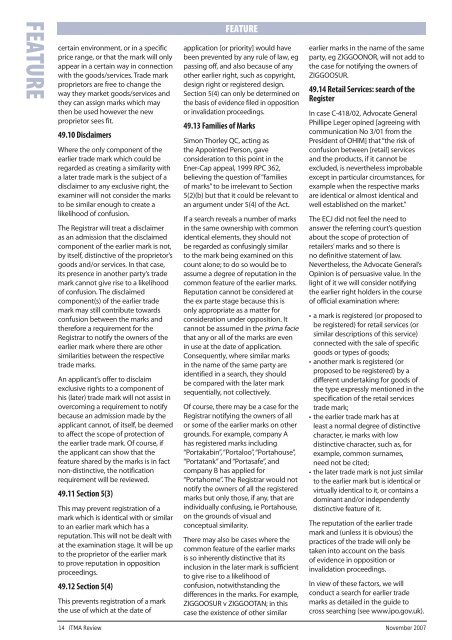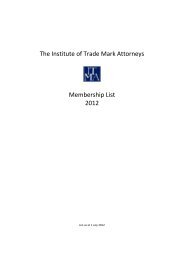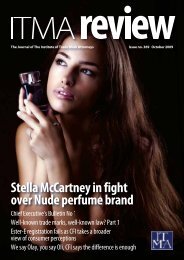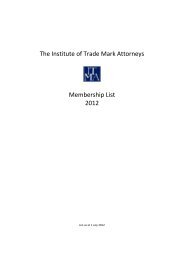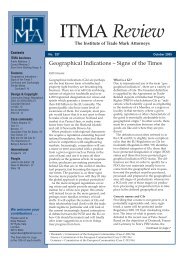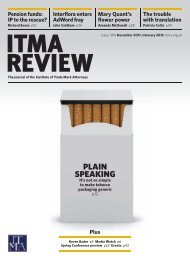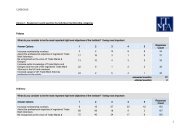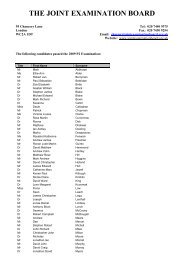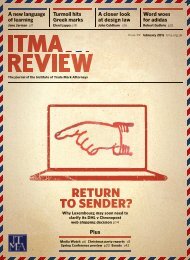ITMA Autumn Conference: Treviso provides cultured backdrop for ...
ITMA Autumn Conference: Treviso provides cultured backdrop for ...
ITMA Autumn Conference: Treviso provides cultured backdrop for ...
You also want an ePaper? Increase the reach of your titles
YUMPU automatically turns print PDFs into web optimized ePapers that Google loves.
FEATURE<br />
certain environment, or in a specific<br />
price range, or that the mark will only<br />
appear in a certain way in connection<br />
with the goods/services. Trade mark<br />
proprietors are free to change the<br />
way they market goods/services and<br />
they can assign marks which may<br />
then be used however the new<br />
proprietor sees fit.<br />
49.10 Disclaimers<br />
Where the only component of the<br />
earlier trade mark which could be<br />
regarded as creating a similarity with<br />
a later trade mark is the subject of a<br />
disclaimer to any exclusive right, the<br />
examiner will not consider the marks<br />
to be similar enough to create a<br />
likelihood of confusion.<br />
The Registrar will treat a disclaimer<br />
as an admission that the disclaimed<br />
component of the earlier mark is not,<br />
by itself, distinctive of the proprietor’s<br />
goods and/or services. In that case,<br />
its presence in another party’s trade<br />
mark cannot give rise to a likelihood<br />
of confusion. The disclaimed<br />
component(s) of the earlier trade<br />
mark may still contribute towards<br />
confusion between the marks and<br />
there<strong>for</strong>e a requirement <strong>for</strong> the<br />
Registrar to notify the owners of the<br />
earlier mark where there are other<br />
similarities between the respective<br />
trade marks.<br />
An applicant’s offer to disclaim<br />
exclusive rights to a component of<br />
his (later) trade mark will not assist in<br />
overcoming a requirement to notify<br />
because an admission made by the<br />
applicant cannot, of itself, be deemed<br />
to affect the scope of protection of<br />
the earlier trade mark. Of course, if<br />
the applicant can show that the<br />
feature shared by the marks is in fact<br />
non-distinctive, the notification<br />
requirement will be reviewed.<br />
49.11 Section 5(3)<br />
This may prevent registration of a<br />
mark which is identical with or similar<br />
to an earlier mark which has a<br />
reputation. This will not be dealt with<br />
at the examination stage. It will be up<br />
to the proprietor of the earlier mark<br />
to prove reputation in opposition<br />
proceedings.<br />
49.12 Section 5(4)<br />
This prevents registration of a mark<br />
the use of which at the date of<br />
FEATURE<br />
application [or priority] would have<br />
been prevented by any rule of law, eg<br />
passing off, and also because of any<br />
other earlier right, such as copyright,<br />
design right or registered design.<br />
Section 5(4) can only be determined on<br />
the basis of evidence filed in opposition<br />
or invalidation proceedings.<br />
49.13 Families of Marks<br />
Simon Thorley QC, acting as<br />
the Appointed Person, gave<br />
consideration to this point in the<br />
Ener-Cap appeal, 1999 RPC 362,<br />
believing the question of “families<br />
of marks” to be irrelevant to Section<br />
5(2)(b) but that it could be relevant to<br />
an argument under 5(4) of the Act.<br />
If a search reveals a number of marks<br />
in the same ownership with common<br />
identical elements, they should not<br />
be regarded as confusingly similar<br />
to the mark being examined on this<br />
count alone; to do so would be to<br />
assume a degree of reputation in the<br />
common feature of the earlier marks.<br />
Reputation cannot be considered at<br />
the ex parte stage because this is<br />
only appropriate as a matter <strong>for</strong><br />
consideration under opposition. It<br />
cannot be assumed in the prima facie<br />
that any or all of the marks are even<br />
in use at the date of application.<br />
Consequently, where similar marks<br />
in the name of the same party are<br />
identified in a search, they should<br />
be compared with the later mark<br />
sequentially, not collectively.<br />
Of course, there may be a case <strong>for</strong> the<br />
Registrar notifying the owners of all<br />
or some of the earlier marks on other<br />
grounds. For example, company A<br />
has registered marks including<br />
“Portakabin”, “Portaloo”, “Portahouse”,<br />
“Portatank” and “Portasafe”, and<br />
company B has applied <strong>for</strong><br />
“Portahome”. The Registrar would not<br />
notify the owners of all the registered<br />
marks but only those, if any, that are<br />
individually confusing, ie Portahouse,<br />
on the grounds of visual and<br />
conceptual similarity.<br />
There may also be cases where the<br />
common feature of the earlier marks<br />
is so inherently distinctive that its<br />
inclusion in the later mark is sufficient<br />
to give rise to a likelihood of<br />
confusion, notwithstanding the<br />
differences in the marks. For example,<br />
ZIGGOOSUR v ZIGGOOTAN; in this<br />
case the existence of other similar<br />
earlier marks in the name of the same<br />
party, eg ZIGGOONOR, will not add to<br />
the case <strong>for</strong> notifying the owners of<br />
ZIGGOOSUR.<br />
49.14 Retail Services: search of the<br />
Register<br />
In case C-418/02, Advocate General<br />
Phillipe Leger opined [agreeing with<br />
communication No 3/01 from the<br />
President of OHIM] that “the risk of<br />
confusion between [retail] services<br />
and the products, if it cannot be<br />
excluded, is nevertheless improbable<br />
except in particular circumstances, <strong>for</strong><br />
example when the respective marks<br />
are identical or almost identical and<br />
well established on the market.”<br />
The ECJ did not feel the need to<br />
answer the referring court’s question<br />
about the scope of protection of<br />
retailers’ marks and so there is<br />
no definitive statement of law.<br />
Nevertheless, the Advocate General’s<br />
Opinion is of persuasive value. In the<br />
light of it we will consider notifying<br />
the earlier right holders in the course<br />
of official examination where:<br />
a mark is registered (or proposed to<br />
be registered) <strong>for</strong> retail services (or<br />
similar descriptions of this service)<br />
connected with the sale of specific<br />
goods or types of goods;<br />
another mark is registered (or<br />
proposed to be registered) by a<br />
different undertaking <strong>for</strong> goods of<br />
the type expressly mentioned in the<br />
specification of the retail services<br />
trade mark;<br />
the earlier trade mark has at<br />
least a normal degree of distinctive<br />
character, ie marks with low<br />
distinctive character, such as, <strong>for</strong><br />
example, common surnames,<br />
need not be cited;<br />
the later trade mark is not just similar<br />
to the earlier mark but is identical or<br />
virtually identical to it, or contains a<br />
dominant and/or independently<br />
distinctive feature of it.<br />
The reputation of the earlier trade<br />
mark and (unless it is obvious) the<br />
practices of the trade will only be<br />
taken into account on the basis<br />
of evidence in opposition or<br />
invalidation proceedings.<br />
In view of these factors, we will<br />
conduct a search <strong>for</strong> earlier trade<br />
marks as detailed in the guide to<br />
cross searching (see www.ipo.gov.uk).<br />
14 <strong>ITMA</strong> Review November 2007


